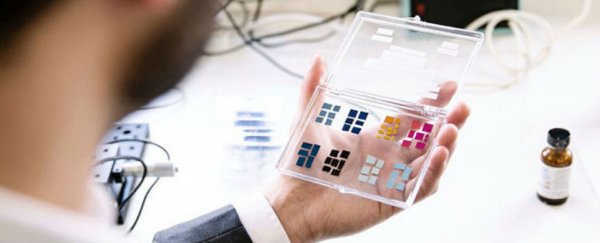Scientists in the UK have invented a new type of touchscreen material that requires very little power to illuminate, offering up a cheap alternative to today's smartphone and tablet screens, with vivid colours and high visibility in direct sunlight.
The team is already in talks with some of the world's largest consumer electronics corporations to see if their new material can replace current LCD touchscreens in the next couple of years, which could spell the end for daily smartphone charging. "We can create an entire new market," one of the researchers, Peiman Hosseini, told The Telegraph. "You have to charge smartwatches every night, which is slowing adoption. But if you had a smartwatch or smart glass that didn't need much power, you could recharge it just once a week."
Developed by Bodie Technologies, a University of Oxford spin-off company, the new display is reportedly made from a type of phase-change material called germanium-antimony-tellurium, or GST. The researchers are being understandably cagey about exactly how it's made as they shop the technology around, but it's based on a paper they published last year describing how a rigid or flexible display can be formed from microscopic 'stacks' of GST and electrode layers.
Each stack is made of a single 7-nanometre-thick layer of GST inserted between two layers of a transparent electrode. This stack is fed a very low-energy electric current to produce colour images.
"Initially, still images were created using an atomic force microscope, but the team went on to demonstrate that such tiny 'stacks' can be turned into prototype pixel-like devices," The Engineer reports. "These 'nano-pixels' - just 300 by 300 nanometres in size - can be electrically switched 'on' and 'off' at will, creating the coloured dots that would form the building blocks of an extremely high-resolution display technology."
They say their ultra-thin display material can produce vivid colour displays at very high resolution - even when hit with bright, direct sunlight - because of the way it manipulates incoming light. "This makes them potentially useful for 'smart' glasses, foldable screens, windshield displays, and even synthetic retinas that mimic the abilities of photoreceptor cells in the human eye," says the team.
With very little electricity required to illuminate a display made from this special 'GST sandwich' configuration, the team says they could dramatically cut the overall amount of power consumed by a smartphone.
Often when we're using our smartphones and smartwatches, the majority of the power is being used to keep the display running, which includes an LCD panel, touchscreen, and backlight. Replacing this with a low-energy alternative could see us ditching the nightly charge for a far more convenient weekly charge.
We'll have to wait and see if announcements will be made about big commercial partnerships, but the researchers are confident they'll have a prototype out within the next 12 months. Maybe this will be the technology that finally breaks us free from our utter dependance on our phone cords.
